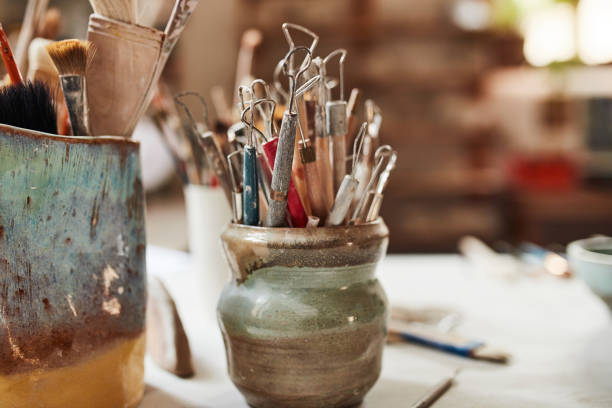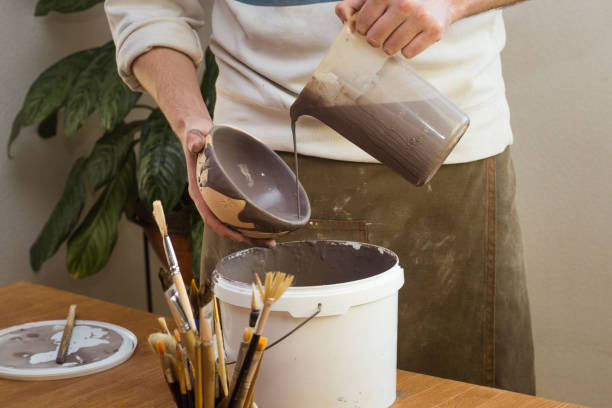There are so many nick-nacks and doohickeys when it comes to pottery. Eventually, you’ll have your favorites that you can’t live without.
Mid South ceramics supply will help you get started and grow with your craft. From trimming your work to creating intricate designs, this is a great set for beginners and pros alike!

Needle Tool
A needle tool is a small, slender rod-like implement that has a pointed end and an opposite end slotted to carry thread. It is used to create fine detail in a piece of clay, or to make bead holes in unbaked polymer clay.
To use a needle tool, place the handle in your dominant hand between the thumb and forefinger. Then, insert the wire loop of the needle threader into the eye of the needle. Pull the threader to make sure it is snug.
If your threader doesn’t work, try placing a piece of white paper behind it. This will provide better contrast and help you see the threader and needle eye more easily.
Another option is to use a needle insert tool. This handy little tool is similar to a needle threader, but it has a smooth wooden handle. Some artists prefer this option, as it feels warmer and more comfortable in the hands. Plus, it is great for preventing accidental pricks when handling delicate clay pieces. It is also ideal for scoring clay pieces to prepare them for joining.
Potter’s Rib
The pottery rib is an essential tool for anyone working with clay, whether on the wheel or hand building. This smooth-finished hardwood rib is available in the basic shapes needed for opening, trimming, shaping, and curving wet clay. It’s the perfect size for fitting into the palm of your hand and can be used to achieve forms that can’t be achieved with fingers alone.
When you’re forming larger forms that require more elegantly curved walls, the combination of pushing out from the inside with the wood rib, and then compressing and strengthening the wall with the metal rib can cause the previously hidden finger ridges to resurface, creating a striped pot (see photos 11-13). Using a Kemper Metal Scraper Rib in the final shaping of your large form can help keep these resurfacing ridges to a minimum.
Another option for a rib is to use the flat edge of a kitchen countertop sample (available for free at home improvement or flooring sales) instead of a traditional wooden rib. This makes a great rib because it is rigid, doesn’t need to be sharpened, and won’t break.

Pin Tool
The Pin Tool makes working with VEX GO pieces even easier by allowing you to open and close a set of pins using the handles just like a pair of pliers. Simply place the tool over the unwanted pin, squeeze and pull. The tool has two other features on its handle that help with disassembly, including one side constructed to push out pins.
The tool also allows you to edit the properties of a specific pin after it has been created or double-clicked. This can be useful for adjusting the color or style of a particular pin. You can also use the tool to center the image view on the selected pin.
This version of Pin has been fully adopted to use the LLVM C++ runtime and includes an example project template for Visual Studio that uses clang-cl. It also contains documentation for good practices when using LLVM C++ tools. This version of Pin can be used to instrument Linux, Windows and Mac OS executables for Intel (R) IA-32, IA-64, and Itanium (R) processors. It is provided and supported free of charge, under the Intel Simplified Software License.
Throwing Stick
Pottery adds a unique flair to home decor. Whether hung sparingly across the mantelpiece or as a central focus in a room, pottery makes for a unique design accessory that provides an artistic antidote to homogenous decor.
You’ll also need a clay trimming tool, which is a long stick that you use to cut excess clay from a piece after it has been dried. It helps make the process much faster and simpler than using your fingers.
Another handy tool is a sponge that you can attach to your throwing stick to help absorb or distribute water while shaping clay. This is especially helpful when you’re working with a large amount of clay.
Wooden modeling tools together with ceramic and pottery tools are useful for sculpting, carving, and shaping clay. They come in an array of shapes and sizes. For example, the P4 Teardrop Fluting Pottery Tool has a stainless-steel blade that creates shallow yet wide flute grooves. It has a short handle to increase maneuverability and allows for faster turning during pottery sculpting. This tool is ideal for tall narrow-necked forms that can pose challenges as a potter.
Trimming Tool
This set features 6 different sharp precision trimming blades, each with a rubber handle that ensures comfort and a secure grip. These tools are hand-crafted and can be resharpened.
This is a unique tool has developed to eliminate the need for switching between dozens of different clay working tools. It combines the broad surface of his favorite loop tool with the more precise cutting edge of the Japanese style kanna (or spade) trim tool.
Using this tool allows you to center a pot by following the inside shape instead of trying to match it up with the chuck rim. This method also avoids “S” cracking that can occur when a pot is trying to connect to the chuck without being properly centered.
Center your pot on the chuck making sure it is centered and level, apply pressure with a subtle twisting motion. Then start removing clay from the outside mark of the foot. Tap the foot frequently as you remove clay listening for a change in the sound as the thickness of the foot changes.



